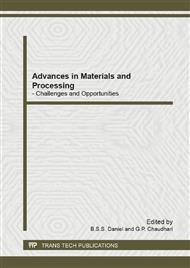[1]
V. H. Grassian, When size really matters: size-dependent properties and surface chemistry of metal and metal oxide nanoparticles in gas and liquid phase environment, J Phys Chem C 112(47) (2008) 18303-18313.
DOI: 10.1021/jp806073t
Google Scholar
[2]
S. Xiong, W. Qi, Y. Cheng, B. Huang, M. Wang, Y. Li, Universal relation for size dependent thermodynamic properties of metallic nanoparticles, Phys Chem Chem Phys 13 (2011) 10652-10660.
DOI: 10.1039/c0cp90161j
Google Scholar
[3]
O. V. Salata, Application of nanoparticles in biology and medicine, J nanobiotechnology 2 (2004) 3-9.
Google Scholar
[4]
H. S. Shin, J. Yu, Size-dependent lattice parameters of microstructure-controlled Sn nanowires, J Mater Res 26(16) (2011) 2033-2039.
DOI: 10.1557/jmr.2011.218
Google Scholar
[5]
C. Srivastava, S. Chithra, K. D. Malviya, S. K. Sinha, K. Chattopadhyay, Size dependent microstructure for Ag-Ni nanoparticles, Acta Mater 59 (2011) 6501-6509.
DOI: 10.1016/j.actamat.2011.07.022
Google Scholar
[6]
Faraday Discuss 138 (2008) 119-135.
Google Scholar
[7]
Schamp C T, and Jesser W A. Metallurgical and Materials Transaction A 2006; 37A: 1825-1829.
Google Scholar
[8]
H. Yasuda, H. Mori, Phase diagrams in nanometer-sized alloy systems, J Cryst Growth 237 (2002) 234-238.
DOI: 10.1016/s0022-0248(01)01881-4
Google Scholar
[9]
H. Yasuda, H. Mori, Spontaneous alloying of zinc atoms into gold clusters and formation of compound clusters, Phys Rev Lett 69 (1992) 3747-3750.
DOI: 10.1103/physrevlett.69.3747
Google Scholar
[10]
Z. Peng, H. Yang, Ag–Pt alloy nanoparticles with the compositions in the miscibility gap, J Solid State Chem 181 (2008) 1546-1551.
DOI: 10.1016/j.jssc.2008.03.013
Google Scholar
[11]
D Mott, J Luo, A Smith, P N Njoki, L Wang, C J Zhong, Nanocrystal and surface alloy properties of bimetallic Gold-Platinum nanoparticles, Nanoscale Res Lett 2 (2006) 12-16.
DOI: 10.1007/s11671-006-9022-8
Google Scholar
[12]
R. E. Reed-Hill, Physical Metallurgy Principles, Litton Educational Publishing, Inc, New York, 1973.
Google Scholar
[13]
D. A. Porter, K. E. Easterling, M. Y. Sherif, Phase Transformation in Metal and Alloys, third ed., CRC Press, Boca Raton 2009.
Google Scholar
[14]
Q. Jiang, D. S. Jhao, M. Zhao, Size-dependent interface energy and related interface stress, Acta Mater 49 (2001) 3143-3147.
DOI: 10.1016/s1359-6454(01)00232-4
Google Scholar
[15]
J. Weissmuller, P. Bunzel, G. Wilde, Two phase equilibrium in small alloy particles, Scripta Mater 51 (2004) 813-818.
DOI: 10.1016/j.scriptamat.2004.06.025
Google Scholar
[16]
H. M. Lu, Q. Jiang, Size-dependent surface energy of nanocrystals, J Phys Chem B 108 (2004) 5617-5619.
Google Scholar
[17]
S. Xiong , W. Qi , Y. Cheng , B. Huang , M. Wang, Yejun Li, Modeling size effects on the surface free energy of metallic nanoparticles and nanocavities, Phys Chem Chem Phys 13 (2011) 10648-10651.
DOI: 10.1039/c0cp02102d
Google Scholar
[18]
M. Singleton, P. Nash, The Ag-Ni (Siler-Nickel) system, J Phase Equilib 8(2) (1987) 119-121.
Google Scholar
[19]
C. Srivastava, S. K. Sinha, Ultra fine scale microstructure for Ag-Fe nanoparticles, Chem Phys Lett 514 (2011) 307-310.
DOI: 10.1016/j.cplett.2011.08.052
Google Scholar
[20]
L. J. Swartzendruber, The Ag-Fe (Silver-Iron) system, J Phase Equilib 5(6) (1984) 560-564.
Google Scholar
[21]
S. A. Nepijko, E. Pippel, J. Woltersdorf, Dependence of lattice parameter on particle size, Phys Status Solidi (A) 61(2) (2006) 469-475.
DOI: 10.1002/pssa.2210610218
Google Scholar
[22]
K. T. Jacob, S. Raj, L. Rannesh, Vegard's law: a fundamental relation or an approximation?, Int J Mater Res 9 (2007) 776-779.
DOI: 10.3139/146.101545
Google Scholar
[23]
W. A. Jesser, C. T. Schamp, Nanoparticle semiconductor compositions in the miscibility gap, Phys Stat Sol 5(2) (2008) 539-544.
DOI: 10.1002/pssc.200776825
Google Scholar
[24]
J. H. He, H. W. Sheng, E. Ma. The enthalpy state of amorphous alloys in an immiscible system. Appl Phys Lett 78(10) (2001) 1343-45.
DOI: 10.1063/1.1352040
Google Scholar
[25]
W. J. Huang, R. Sun, J. Tao, L. D. Menard, R. G. Nuzzo, J. M. Zuo, Coordination-dependent surface atomic contraction in nanocrystals revealed by coherent diffraction, Nat Mater 7 (2008) 308-313.
DOI: 10.1038/nmat2132
Google Scholar
[26]
C. Srivastava, B. M. Mundotiya, Morphology dependence of Ag-Ni solid solubility, Electrochem Solid ST 15(2) (2012) K10-K15.
DOI: 10.1149/2.003202esl
Google Scholar
[27]
C. Srivastava, Phase separation by nanoparticle splitting, Mater Lett 70 (2012) 122-124.
Google Scholar
[28]
I. Karakaya, W. T. Thompson, The Ag-Co (Silver-Cobalt) system, J Phase Equilib 7(3) (1986) 259-263.
Google Scholar
[29]
E. Ma, Alloys created between immiscible elements, Prog Mater Sci 50(4) (2005) 413-509.
Google Scholar
[30]
S. Nag, K. C. Mahdak, A. Devaraj, S. Gohil, P. Ayyub, R. Banerjee, Phase separation in immiscible silver-copper alloy thin films, J Materials Science 44(13) (2009) 3393-3401.
DOI: 10.1007/s10853-009-3449-0
Google Scholar


